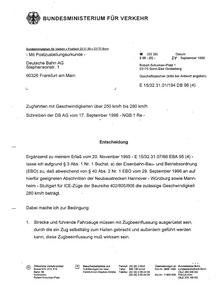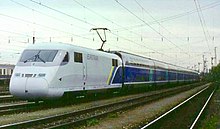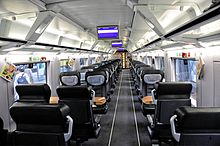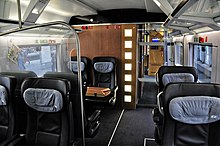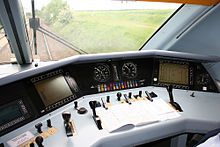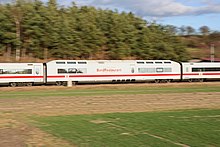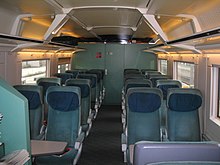ICE 2
| ICE 2 | |
|---|---|
|
ICE-2 half train in Radbruch
|
|
| Numbering: | DB 402 001-046 (power cars) |
| Number: | 44 multiple units; 2 reserve power cars u. 1 reserve control car |
| Manufacturer: | "Working Group ICE 2" Siemens / Adtranz u. a. |
| Year of construction (s): | 1994-1998 |
| Retirement: | from approx. 2026 |
| Axis formula : | Bo'Bo ' |
| Genre : | ICE |
| Gauge : | 1435 mm ( standard gauge ) |
| Length over coupling: | 20,560 mm (power car) |
| Length: | 205.36 meters (powered end car, 6 intermediate cars and control car) |
| Height: | 3840 mm (power end) |
| Width: | 3070 mm (power end)
3020 mm (middle car) |
| Bogie axle base: | 3,000 mm (power car) 2,500 mm (intermediate car) |
| Empty mass: | 77.5 t (powered end car), 412 t (7-car train including control car) |
| Service mass: | 455 t (redesign train) |
| Wheel set mass : | 19.5 t |
| Top speed: | 280 km / h |
| Continuous output : | 4,800 kW |
| Starting tractive effort: | 200 kN |
| Performance indicator: | 61.9 kW / t (power car), 11.6 kW / t (multiple unit) |
| Impeller diameter: | 920 mm (new) 860 mm (worn) |
| Power system : | 15 kV 16.7 Hz |
| Number of traction motors: | 4th |
| Drive: | universal joint |
| Brake: | KE R + E |
| Train control : | Sifa , LZB 80/16 with PZB 90 |
| Coupling type: | Scharfenberg coupling |
| Seats: | 368 (before redesign) 381 (after redesign) |
| Floor height: | 1226 mm above SO |
As ICE 2 , the second series of is InterCity Express - unit trains of Deutsche Bahn referred.
An ICE 2 trainset is scheduled from a power car of the class 402 , six intermediate cars of series 805, 806 and 807 and a control car of series 808 formed. Two ICE-2- halfmoves can by means of an automatic coupling to an execution are compiled. In isolated cases, ICE 2 power cars are also used in ICE 1 trains.
Due to the fact that the loading gauge is exceeded , the trains, in addition to the ICE 1 and Metropolitan trains, are operationally part of the ICE A group .
The 44-unit trains were initially in ICE plant in Munich home . On June 1, 2000, the trains were handed over to the Berlin-Rummelsburg depot .
history
background
After detailed investigations of the traffic volume on the first ICE lines, the second generation of ICE trains should no longer consist of long trains , but of 200 m long half trains. The requirements for the new ICE generation were laid down by November 1991 and the specifications were drawn up by autumn 1992 .
procurement
The trains emerged from a project study by the former Deutsche Bundesbahn in 1992, in which the requirements for the second generation of ICE trains were determined. These were needed in particular for the high-speed line Hanover – Berlin , which went into operation in 1998 , and were intended to be used on less popular routes on which the ICE 1 with around 700 seats was not economical. One of the plans was to run two parts of the train from Berlin to Hanover and to separate them in Hanover. One part of the train should go towards the Ruhr area , the other towards Bremen . A concept consisting of a powered end car, six intermediate cars and a control car was identified as the most economical variant. Trains should also be made up of one power car and five intermediate cars as well as two power cars and 14 intermediate cars. In addition, the weight of the trains should be significantly reduced. A planned, new catering concept on the ICE 2 trains was not implemented.
The tender for the second generation of ICE was started on October 21, 1992. The new trains were referred to as ICE 2 for the first time . In January 1993 the formal tender was issued; on August 17, 1993 (other source: August 13, 1993) the Deutsche Bundesbahn announced its intention to purchase 60 ICE-2 multiple units from a bidding consortium under the leadership of Siemens , with AEG , ABB Daimler Benz Transportation (later Adtranz ) and participation of the Germans Waggonbau (DWA). The vehicles should be delivered from the end of 1996. In addition, two reserve drive heads and a replacement control car were ordered. In addition, 25 ordered 1st and 2nd class seated cars (classes 806.9 and 805.9) were combined as class 802.9 and added to ICE 1 trains after the seating capacity in 2nd class of ICE 1 turned out to be insufficient.
In December 1993 the contracts were ready to be signed. The Federal Ministry of Transport and the Federal Ministry of Finance approved the procurement of the trains. The planning provided for 44 half-train sets (without control cars) to be procured initially and 22 long trains to be formed from them. These units should be ready for the commissioning of the high-speed line Hanover – Berlin in May 1997 and run there as long trains between Hanover and Berlin. One year later (May 1998) the newly developed control cars should be available, and the trains were finally to be converted into 44 half-trains. As half-trains, individual ICE-2 multiple units should run in particular in the peripheral areas and on certain route sections. In addition, the later delivery of 13 more ICE half-trains and an option for 60 additional trains, each with a conversion right. These purchase intentions ultimately led to the delivery contract for the ICE 3 , using the conversion right .
At the beginning of 1994, the series designations for the new vehicles were fixed.
In the summer of 1994, it was planned to implement 13 of the option to 60 additional sets as multi-system vehicles. They should be used in traffic between Cologne and Amsterdam. The trains should have a drive on numerous axles and a narrower vehicle gauge (according to European standards). Nine of the 13 trains were designed as three-system trains, the remaining four should be able to run in four different national rail systems. The multi-system ICE 2 was to be delivered together with the ICE 2 trains for domestic traffic in 1997.
In January 1994 Grammer AG received the order to build the seats. In April 1994 Waggonbau Ammendorf GmbH, a subsidiary of Deutsche Waggonbau AG, received the order for the complete interior fitting of 70 1st and 2nd class cars.
The power cars were manufactured in the shell by ABB in Kassel (previously Henschel ) and Krauss-Maffei (Munich) and finally assembled by Siemens in Essen (formerly Krupp locomotive and wagon construction factory ); The bogies were also made in Essen. The 1st class intermediate cars were built at AEG in Nuremberg and DWA in Ammendorf. The 2nd class cars were manufactured by DUEWAG in Krefeld-Uerdingen and LHB in Salzgitter . LHB also supplied the dining car, AEG the control car. A total of 13 direct contractors were involved in the production of the ICE 2 multiple units. The first powered end car, 402 001, was subjected to temperature and icing tests between November 30, 1995 and December 11, 1995 in the climatic chamber in the Vienna Arsenal . With the completion of power car 402 046 on March 3, 1997, rail vehicle production at Krupp in Essen also ended.
Before starting vehicle production for the Metropolitan , which went into operation in 1999 , the board of directors of Deutsche Bahn considered withdrawing two trains from ongoing ICE-2 production and equipping them with a special interior for the Metropolitan. This plan was dropped due to the high cost of the necessary production changes. In 1996 ICE 2 intermediate cars were temporarily prepared for the conversion. They were given a metallic paint and a dark gray strip at about the level of the ICE window strip. This order was later canceled. The affected vehicles of the 805 and 806 series were accepted by Deutsche Bahn in June 1998 as the last intermediate wagons; only the reserve car 808 045 was still outstanding at this time.
Installation
The commissioning of the first power car in Munich began in mid-1995. On December 13, 1995, the first ICE-2 intermediate car was presented to the public at AEG in Nuremberg.
On September 6, 1996, the first roll-out of an ICE-2 long train (with two power cars and nine intermediate cars) followed in Munich . The train formation and commissioning was carried out by Siemens in the ICE depot in Munich . At the request of Deutsche Bahn, the Federal Ministry of Transport issued an exceptional permit for operation at 280 km / h for the first time on September 24, 1996, in deviation from the general maximum speed specified in Section 40 Paragraph 2 No. 1 of the Railway Construction and Operating Regulations of 250 km / h. When the timetable changed on December 13, 2009, the permitted speed on the new Nuremberg – Ingolstadt line and on sections of the high-speed lines Hanover – Würzburg and Mannheim – Stuttgart was increased to 280 km / h.
The first ICE 2 multiple units were used as scheduled for the timetable change on September 29, 1996. Like the ICE 1, they were initially painted in the so-called product colors of the Deutsche Bundesbahn , which means that they originally had a wide decorative stripe in oriental red (RAL 3031) and a narrow decorative stripe in pastel violet (RAL 4009). The vehicles ran, similar to the ICE 1, as long trains with nine cars. Because the dining car has not yet been delivered, an at-the-seat service with food and drinks was offered in both classes. These long trains were also referred to as "mega trains".
| Serial number | TK | [14] | [12] | [11] | [10] | [05] | [04] | [03] | [02] | [01] | TK |
|---|---|---|---|---|---|---|---|---|---|---|---|
| Block train (9 cars; without bistro) | 402.0 | 805.3 | 805.0 | 805.0 | 806.3 | 806.0 | 806.3 | 806.3 | 806.6 | 806.6 | 402.0 |
| Block train (9 cars; with bistro) | 402.0 | 805.3 | 805.0 | 805.0 | 807.0 | 806.0 | 806.3 | 806.3 | 806.6 | 806.6 | 402.0 |
In 1996 the ICE-2 multiple units achieved a performance of 0.7 million train kilometers, in the following year 5.1 million train kilometers.
The trains initially ran between Bremen and Frankfurt am Main. By omitting all previous intermediate stops, with the exception of Hanover, the travel time on this route was reduced by ten minutes. In addition, the trains were used in peripheral locations between Dortmund and Frankfurt and between Frankfurt and Munich. In addition, the train service between Frankfurt and Berlin has been increased from nine to 13 train pairs with the new multiple units. In the 1996/97 winter schedule, the ICE Sprinter 990 and 993 between Munich and Frankfurt am Main and the ICE 920 from Munich to Frankfurt am Main were also served by ICE 2.
An ICE-2 multiple unit was presented in spring 1997 at the 150th anniversary of the Danish Railways in Copenhagen .
On June 1, 1997, the trains ran as long trains between Berlin and Cologne, via Magdeburg. From autumn 1997, short trains (with control cars) were also used. This was the first time that a multiple unit operated in Europe that was approved for speeds of 280 km / h when driving with a control car and a trailing power car.
| Serial number | TK | [x7] | [x6] | [x5] | [x4] | [x3] | [x2] | [x1] | [y1] | [y2] | [y3] | [y4] | [y5] | [y6] | [y7] | TK |
|---|---|---|---|---|---|---|---|---|---|---|---|---|---|---|---|---|
| Long train without control car (12 cars; 1997) | 402.0 | 805.3 | 805.0 | 807.0 | 806.0 | 806.3 | 806.6 | - | - | 806.6 | 806.3 | 806.0 | 807.0 | 805.0 | 805.3 | 402.0 |
From January 18, 1998, the first ICE-2 half-trains ran on schedule. For example, the ICE Sprinter 990 ( Rhein-Sprinter ) between Munich and Frankfurt am Main was served by an ICE-2 half-train. The majority of the trains ran with the powered end car in front, as the maximum speed with the leading control car was still limited to 200 km / h.
After the commissioning of all control cars had been completed, ICE 2 trains started running as planned with one wing in Hamm on May 24, 1998 (timetable change). To this day, two train parts each run unified between Berlin and Hamm and are divided there. One part runs via Wuppertal to Cologne, the other via the Ruhr area (Düsseldorf and others) to the same destination. After repeated overstaffing between Berlin and Düsseldorf (line 10), the ICE multiple units on line 6B (Berlin-Magdeburg-Braunschweig) were replaced by locomotive-hauled trains from February 12, 1999, and thus those that had only operated with one train part ICE 2 of line 10 reinforced by another train section for weekend traffic.
From the timetable change at the end of May 1998, ICE 2 operated as a so-called trial ICE in place of wagon trains on IC line 1 between Nuremberg and Dortmund, in order to free up the previously used IC wagons for modernization. This operation, planned until September 1998, was canceled after the ICE accident in Eschede in June 1998 and the multiple units were used in replacement ICE 1 traffic.
Further development
As part of the Eurotrain project , TGV duplex intermediate cars were connected to the ICE 2 power cars 402 042 and 402 046 for demonstration purposes in 1998 . Attempts to sell such ICE-TGV combinations on Asian markets failed.
On January 19, 1999, two wagons of multiple unit 241 derailed in Hanover Central Station due to a broken piece of the focal point. Nobody was injured, the property damage was estimated at 300,000 Deutschmarks.
Since May 30, 1999, the trains have also been running between Hamburg / Bremen and Munich, with a wing in Hanover. In the early summer of 1999, the trains began to be equipped with new coupling software, after frequent coupling problems had previously occurred.
From December 5, 2000, four pairs of trains were temporarily operated between Hamburg and Berlin with ICE 2.
From the beginning of 2001, a bogie developed by Bombardier - Talbot was tested in an ICE-2 intermediate car , which was the result of a cooperation between DB and Japan Railways that had existed since 1993 .
By the turn of the year 2004/2005, the ICE-2 fleet had covered around 140 million kilometers, individual multiple units up to 3.5 million kilometers.
On July 4, 2008, after welding work, the 402 032 powered end car burned on the premises of the ICE depot in Berlin-Rummelsburg and was damaged in the process.
In the summer of 2009 there were three fires on ICE-2 power cars in quick succession: in Hanover (July 9), in Bielefeld (August 31) and Berlin-Spandau (August 7). The Federal Railway Authority investigated the incidents and saw no fundamental technical problem.
On July 10, 2010, with outside temperatures of up to 38 degrees, the air conditioning systems in nine cars on the ICE 846/856 (multiple units 201 and 213) from Berlin to Cologne failed. In addition, the train crew had switched off the fresh air supply in three cars to restart the systems. In connection with an overstaffing of the train, there was a build-up of heat and rising temperatures in several cars. 27 travelers suffered shortness of breath , circulatory problems and collapses , 9 people were admitted to hospitals. According to an internal incident analysis, up to 61 degrees were measured in one of the train's energy supply blocks.
After the Federal Railway Authority wanted to limit the inspection intervals for wheelsets to 20,000 km, Deutsche Bahn voluntarily halved the intervals from the previous 570,000 km to 250,000 to 300,000 km. In February 2011, the Deutsche Bahn halved the interval again according to its own information.
At the end of December 2012, Deutsche Bahn tendered the conversion of initially two ICE 2 power cars from GTO converters to converters with IGBT technology. One option is to equip the remaining 44 power cars. The order was awarded to Mitsubishi for 22 million euros , and tests on a multiple unit took place at the end of 2015 on the Velim railway test ring . The GTO converters released during the conversion are to serve as spare parts for 39 ICE 1 multiple units that are no longer to receive IGBT converters.
On December 4, 2018, a smoldering fire broke out at power end 402 012 in Hanover Central Station , which, according to Deutsche Bahn, was due to "smoke development in the engine area".
During the COVID-19 pandemic in Germany , some of the trains used between Cologne and Berlin were temporarily withdrawn due to low demand and used as a replacement for the temporarily parked ICE 1. From May 18, 2020, the trains on the line were again formed from two ICE 2 multiple units.
The ICE 2 will be the only ICE multiple units not to receive any ETCS equipment for the time being .
ICE 2 as a measuring vehicle
In 2007, a multiple unit was equipped with sensors as part of the project "On-vehicle monitoring of the infrastructure in regular operation", which record and transmit data on the track position up to 2000 times per second. By January 2015, it had covered over 5.3 million kilometers without any problems.
Redesign
By 2008, the multiple units had covered up to eight million kilometers and thus achieved the intended performance. Deutsche Bahn examined upgrading the multiple units (similar to the redesign of the ICE 1) for a further 15 years of operation. In autumn 2009, the economic evaluation of various options for the project began. At the same time, consideration was given to adding additional seats.
In mid-May 2009, Deutsche Bahn announced the procurement of around 17,000 seats, 1,600 tables and restaurant seats for all 44 on-board restaurants. The conversion of a sample train began in October 2010. It was presented in February 2011. By mid-December 2011, 16 multiple units had been retrofitted; by the end of 2012, the retrofitting of 38 of 44 multiple units was completed. The last modernized multiple unit left the DB plant in Nuremberg in August 2013.
Up to five weeks of working time were available for each multiple unit. Each car was broken down into more than 12,000 individual parts. Tz 232 was the first multiple unit to be converted. The conversion of the 46 power cars, 45 control cars and 264 intermediate cars will cost more than 100 million euros, according to Deutsche Bahn. Spare parts and equipment accounted for 40 million euros of this. The project aimed to secure 320 jobs in the Nuremberg repair shop.
The number of seats was increased from 368 to 381 as part of the redesign. The new seating was created in place of the previous cloakrooms and climbing frame in the children's compartment. The seat spacing remained unchanged. The new Fainsa MD ICE seats can be tilted towards the front. As a result, other passengers are no longer disturbed to the same extent when they lean back.
As part of the redesign, a separate area with four seats was created in each of the first class cars. These are used as compartment spaces for reservations . With the exception of the toddler compartment, there are still only seats in the open plan in 2nd carriage class.
A socket was installed at every seat in 1st class, and one socket for each double seat in 2nd class. In addition, two new wheelchair spaces with lifting tables and service call buttons have been set up per train. A total of 1280 TFT monitors in ceiling pods are to be used in the 44 trains to provide passenger information.
In addition, 17,000 square meters of carpeting, 5100 roller blinds, 3200 tables and 40,000 square meters of paintwork were renewed. The trains were equipped with hotspot internet access . In the course of the redesign, the anti-roll dampers on the trains were replaced in order to reduce the load on the car bodies .
Replacement with new trains
In the summer of 2008, Deutsche Bahn issued a framework contract under the working title ICx (now referred to as ICE 4 ), under which the ICE 2 is also to be replaced by around 2025. The trains are now planned to be retired from around 2022 (as of 2018).
ICE 2 long train as a short-term ICE 4 replacement
In order to mitigate the operational effects of the ICE 4 acceptance stop, Deutsche Bahn started using an ICE 2 long train on the route from Hamburg via Hanover, Kassel, Würzburg and Nuremberg to Munich from July 3, 2019. In addition to the two power cars, this consists of nine intermediate cars and runs in a one-day circuit as ICE 2797 and ICE 2862 as a replacement for ICE 587 and 782.
| Serial number | TK | 27 | 26th | 25th | 24 | 23 | 22nd | 21st | 29 | 28 | TK |
|---|---|---|---|---|---|---|---|---|---|---|---|
| Long train (9 cars); Multiple unit number 229; Deployment 2019 | 402 029 | 805 325 | 805 028 | 807 026 | 806 039 | 806 339 | 806 629 | 806 608 | 806 615 | 806 305 | 402 046 |
From the timetable change in December 2019, a nine-part ICE 2 operated as ICE 924/923 on the Hamburg - Cologne - Frankfurt route. The multiple unit was last in service on February 22, 2020. A few days later, multiple unit 229 was back in the typical configuration.
outlook
In the course of a planned extension of the service life, consideration is being given to rebuilding the multiple units similar to the ICE 1. Among other things, a configuration with two power cars is being considered.
construction
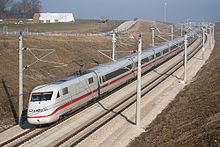
| Serial number | TK | [x7] | [x6] | [x5] | [x4] | [x3] | [x2] | [x1] |
|---|---|---|---|---|---|---|---|---|
| Half train (7 cars; 1998-2011) | 402.0 | 805.3 | 805.0 | 807.0 | 806.0 | 806.3 | 806.6 | 808.0 |
| Redesign (7 cars; 2012) | 402.0 | 805.3 | 805.0 | 807.0 | 806.0 | 806.3 | 806.6 | 808.0 |
In order to better adapt to demand, the multiple units of the 402 series, in contrast to the 401 series , were designed as half trains. Two ICE 2 multiple units can be coupled to one another using a fully automatic Scharfenberg coupling to form a double traction. Both train parts each have a power end from the 402 series and a control car from the 808 series; the intermediate cars have the series numbers 805.0 / 805.3 ( first class ), 806.0 / 806.3 / 806.6 (second class) and 807 (service car with on-board restaurant ). In 1993, test drives with the InterCityExperimental took place to check whether open clutch flaps could be pushed away when trains crossed in the tunnel.
The trains were designed as large areas throughout . With the exception of the toddler compartment , no compartments have been set up. The trains have 368 seats in the open-plan area (including 52 in the control car) and 23 seats in the dining car. The design of the intermediate car allows the seating to be easily converted between 1st and 2nd class.

In principle, an ICE 2 is a very common push-pull train with a locomotive and a control car. Because of the operationally inseparable wagons, the ICE 2 is a classic multiple unit. ICE 2 half-trains driving in front of the control car are the fastest pushed trains in Germany.
In the first years of operation, the trains were considered to be very sensitive to cross winds when pushed (control car in the direction of travel at the front) . The maximum speed was therefore reduced to 200 km / h with the leading control car from the beginning of 1998, whereby the trains on new lines usually ran in double traction, with the two control cars in the middle. The Federal Railway Authority had initially limited the maximum permissible speed to 200 km / h for journeys with the leading control car. Areas endangered by cross winds were examined to allow higher speeds. At the time of the timetable change on September 29, 1998, proof of the high-speed route Hanover – Berlin was provided - with the exception of two areas at risk of cross winds, the maximum speed limit was increased from 200 to 250 km / h. These areas at risk of side winds make up a total of around 60 km in length.
Investigations later showed that the risk of crosswinds varies greatly from one location to another and is concentrated on individual sections of the route. In this section, the maximum permissible speed for a pushed control car was limited to 200 km / h. A wind warning system was also planned to allow the maximum speed in critical sections with the appropriate wind conditions. The limitation on the high-speed line Hanover – Berlin was lifted in May 2000. The prototype of a stationary measuring station was tested at Stendal. Later, the permissible speed should be reduced via the polyline control. In addition to stationary measuring stations, the erection of wind protection fences was also examined. In the end, this concept was also implemented and speed limits were fundamentally avoided. The approach with measuring stations was not pursued any further.
When the trains were being planned in 1994, the Federal Railway Authority made it mandatory for Deutsche Bahn to set up measuring devices at wind-critical locations and to reduce the speed of pushed trains to 200 km / h in the event of danger.
The top speed of 280 km / h is only achieved by individual trains on the new Ingolstadt – Nuremberg line , otherwise it is 250 km / h. The maximum speed of the control car ahead is 250 km / h. If two ICE 2 are coupled, the following speeds result:
- Power end to power end:
- 200 km / h on high-speed routes
- 160 km / h on all other routes.
- Control car on power end:
- Power head ahead: 280 km / h
- Control car ahead: 250 km / h
This is to prevent the overhead line from rocking too much through the two adjacent pantographs (contact breakage, arcing ).
Differences between ICE 1 and ICE 2
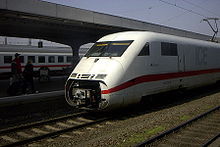
The ICE 2 is visually very similar to the ICE 1 from the outside. The two trains can be differentiated, for example, on the front flap , which is split on 402 powered end cars , but not on the first-generation ICE. Characteristic is a large spar protruding from the front apron of the power car (called "gripper"), which is part of the Scharfenberg coupling and serves to align it, as well as the roof of the on- board restaurant or bistro, which was raised on the ICE 1. The control car used in ICE 2 differs from the powered end car in that it contains a passenger compartment (until 2007 the second class smoker's compartment) and also has no pantographs and no engine. The interior of the car differs significantly from the ICE 1, although the cars are almost identical. Compared to the original ICE 1 seating, the ICE 2 is characterized by its completely different lightweight seats (similar to airplane seats), the electronic seat reservation displays and the large passenger information monitors in the form of gondolas on the car ceiling.
The running bogies of the ICE 1 type MD 530 had coil springs that, in conjunction with monobloc wheels, caused vibrations in the interior of the vehicle. Test bogies were therefore requested from various manufacturers for the ICE 2, mounted on a test basis under the ICE 1 multiple unit 172 and tested in passenger operation. Bogies from the companies Asea Brown Boveri , Simmering-Graz-Pauker , Linke-Hofmann-Busch , SIG , Messerschmitt-Bölkow-Blohm and the Uerdingen wagon factory were used. Compared to the Minden-Deutz bogie of the ICE 1, which weighs 7.4 t including the magnetic rail brake, the tender called for a weight saving of 1.5 t. Finally, the design by Simmering-Graz-Pauker with the designation “SGP 400” prevailed. In the secondary stage, air suspension is used to improve driving comfort, and several hydraulic roll dampers are installed. The wheelset is supported by tapered roller bearings . In addition to the SGP plant in Graz , the running bogies were also manufactured in the ABB plant in Siegen and in the DWA plant in Vetschau .
The main innovations compared to the ICE 1 also include a passenger information system with train movement displays in the boarding area and large displays at both ends of the open-plan cars as well as an electronic reservation system with digital displays above each seat. In the open-plan area, a socket was attached to every table, and video screens were installed in all row seats in 1st class. The innovations also include a family compartment with play equipment.
The weight of each intermediate car has been reduced by around five tons compared to the ICE 1, among other things through a frame-free body shell, the use of new materials and optimization of the energy supply as well as the new lightweight bogies and magnetic rail brakes . Compared to the ICE 1, the roof edges of the ICE 2 are more rounded. By using slimmer seats made of aluminum (previously steel ), the weight of the seats was reduced from around 50 to around 25 kg.
commitment
The wing train concept enables winging as is done on trains on the Berlin - Cologne route . In Hamm , the trains, which were previously made up of two 200-m ICE-2 multiple units, will be divided and will travel via Dortmund , Essen , Duisburg and Düsseldorf , individual trains will continue to Cologne / Bonn Airport station or via Hagen , Wuppertal to Cologne, individual trains to Bonn and Koblenz . The same concept also applies to some trains on the route from Munich to Bremen and Hamburg . Here the trains in Hanover are divided. In the opposite direction, the train parts are coupled again.
With the completion of the newly developed control car, the wing train concept became effective for the timetable change on May 24, 1998. This made ICE 1 long trains available for use on high-demand connections. With the shorter trains, connections with less demand could also be served economically and more connections free of transfers could be offered.
With the timetable change on December 14, 2008, an ICE-2 train pair was used between Lübeck, Hanover and Munich. A new ICE-2 train has been set up, which starts in Aachen in the morning, is combined with another part of the train in Hamm and continues to Berlin.
Individual overview of the multiple units
Between 2002 and 2011, all ICE trains of the 402 series were given the names of cities that had sponsored them. The following is a list of the assignment of multiple unit numbers (2xx - outside, written above the bogies) and city names. The power cars and control cars marked with a g each have a green decorative stripe with the inscription "Germany's fastest climate protector:
| Multiple unit number name |
Acceptance redesign |
Conversions or conversions | assigned power car | assigned control car (BR 808) |
comment |
|---|---|---|---|---|---|
| Item 201 Rheinsberg (since October 15, 2005) |
11/20/1997 09/21/2012 |
Equipped with WiFi hotspots (railnet) | 402 001 g | 808 001 | The control car 808 001 served as a conversion prototype for the redesign and was already running with a modified interior before the first redesign train. |
| Item 202 Wuppertal (since July 1, 2003) |
17.11.1997 08.16.2013 |
Equipped with WiFi hotspots (railnet) | 402 002 g | 808 002 | Last redesign move |
| Item 203 Cottbus / Chóśebuz (since December 7, 2002) |
08/27/1997 07/22/2011 |
Equipped with WiFi hotspots (railnet) | 402 003 g | 808 003 g | |
| Item 204 Bielefeld (since November 15, 2002) |
03/23/1998 02/22/2013 |
Equipped with WiFi hotspots (railnet) | 402 004 g | 808 004 g | |
| Item 205 Zwickau (since July 31, 2004) |
October 29, 1997 May 15, 2011 |
Equipped with WiFi hotspots (railnet) | 402 005 g | 808 005 | |
| Item 206 Magdeburg (since November 25, 2002) |
08.09.1997 31.05.2013 |
Equipped with WiFi hotspots (railnet) | 402 006 g | 808 006 | |
| Item 207 Stendal (since January 13, 2003) |
08/27/1997 02/03/2012 |
Equipped with WiFi hotspots (railnet) | 402 007 g | 808 007 | |
| Item 208 Bonn (since December 17, 2002) |
08.09.1997 14.11.2012 |
Equipped with WiFi hotspots (railnet) | 402 008 | 808 008 | |
| Item 209 Riesa (since August 30, 2003) |
09/04/1997 03/25/2011 |
Equipped with WiFi hotspots (railnet) | 402 009 | 808 009 | |
| Tz 210 Fontanestadt Neuruppin (since March 18, 2006) |
04.09.1997 12.12.2012 |
Equipped with WiFi hotspots (railnet) | 402 010 | 808 010 | |
| Item 211 Uelzen (since 08/30/2008) |
09/16/1997 04/12/2013 |
Equipped with WiFi hotspots (railnet) | 402 011 | 808 011 | |
| Item 212 Potsdam (since March 19, 2003) |
09/16/1997 06/17/2011 |
Equipped with WiFi hotspots (railnet) | 402 012 | 808 012 g | On November 4, 2017 in special paint as "TRAIN TO BONN" to the UN climate conference in Bonn 2017 on the way. |
| Item 213 Nauen (since December 1, 2007) |
02/06/1998 11/11/2011 |
Equipped with WiFi hotspots (railnet) | 402 013 g | 808 013 g | |
| Item 214 Hamm (Westphalia) (since September 27, 2003) |
09/25/1997 08/19/2011 |
Equipped with WiFi hotspots (railnet) | 402 014 g | 808 014 g | |
| Item 215 Bitterfeld (from July 17, 2004 to July 24, 2009) Bitterfeld-Wolfen (since July 25, 2009) |
October 8, 1997 May 21, 2012 |
Equipped with WiFi hotspots (railnet) | 402 015 | 808 015 | |
| Item 216 Dessau (since December 12, 2002) |
17.10.1997 07.12.2013 |
Equipped with WiFi hotspots (railnet) | 402 016 g | 808 016 g | |
| Item 217 Bergen on Rügen (since July 9, 2005) |
09/25/1997 04/27/2011 |
Equipped with WiFi hotspots (railnet) | 402 017 g | 808 017 g | In May and June 2015, the powered end car and first class car had special Pokalexpress stickers for the DFB Cup . |
| Item 218 Braunschweig (since November 12, 2002) |
08.10.1997 25.06.2012 |
Equipped with WiFi hotspots (railnet) | 402 018 g | 808 018 | |
| Item 219 Hagen (since July 19, 2003) |
10/17/1997 02/17/2012 |
Equipped with WiFi hotspots (railnet) | 402 019 g | 808 019 g | |
|
Item 220 Meiningen (since October 1, 2005) |
October 29, 1997 May 4, 2012 |
Equipped with WiFi hotspots (railnet) | 402 020 g | 808 020 g | disbanded, power car and intermediate car leased to DB Systemtechnik for IGBT test drives |
| Item 221 Lübbenau / Spreewald (since March 27, 2004) |
17.11.1997 27.11.2012 |
Equipped with WiFi hotspots (railnet) | 402 021 g | 808 021 g | On July 9, 2009, the power car 402 021-0 caught fire in Hanover main station. |
| Item 222 Eberswalde (since May 12, 2007) |
20.11.1997 29.11.2011 |
Equipped with WiFi hotspots (railnet) | 402 022 g | 808 022 g | |
| Item 223 Schwerin (since October 3, 2003) |
05.01.1998 17.08.2012 |
Equipped with WiFi hotspots (railnet) | 402 023 g | 808 023 g | |
| Item 224 Saalfeld (Saale) (since June 19, 2004) |
05.01.1998 11.01.2013 |
Equipped with WiFi hotspots (railnet) | 402 024 g | 808 024 g | |
| Item 225 Oldenburg (Oldb.) (Since June 27, 2009) |
12/17/1997 10/23/2012 |
Equipped with WiFi hotspots (railnet) | 402 025 g | 808 025 g | |
| Item 226 Lutherstadt Wittenberg (since November 26, 2002) |
December 17, 1997 July 10, 2012 |
Equipped with WiFi hotspots (railnet) | 402 026 | 808 026 | |
| Item 227 Ludwigslust (since August 21, 2004) |
23.12.1997 16.12.2011 |
Equipped with WiFi hotspots (railnet) | 402 027 | 808 027 | In a shunting accident in Berlin-Rummelsburg , drive end 402 027 was badly damaged on May 16, 2014. |
| Item 228 Oldenburg (Oldb.) (From August 5, 2003 to June 26, 2009) Altenburg (since June 27, 2009 ) |
23.12.1997 09.10.2012 |
Equipped with WiFi hotspots (railnet) | 402 028 g | 808 028 g | |
| Item 229 Templin (since March 25, 2006) |
22.01.1998 28.12.2011 |
Equipped with WiFi hotspots (railnet) | 402 029 g | 808 029 | This multiple unit derailed on May 1, 2017 as ICE 945 towards Berlin at the entrance to Dortmund Central Station with a control car and an intermediate car. In service from 3 July 2019 to 22 February 2020 as a long train with a reserve power car 402 046. See section # ICE-2 long train as a short-term ICE-4 replacement |
| Item 230 Delitzsch (since October 9, 2004) |
22.01.1998 31.08.2012 |
Equipped with WiFi hotspots (railnet) | 402 030 g | 808 030 g | In a shunting accident in Berlin-Rummelsburg, the carriages 806 008, 806 309, 806 640 and the reserve control car 808 045 on the multiple unit at that time derailed on May 16, 2014 and were partially badly damaged. |
| Item 231 Brandenburg an der Havel (since May 11, 2004) |
02/08/1998 10/07/2011 |
Equipped with WiFi hotspots (railnet) | 402 031 g | 808 031 | |
| Item 232 Frankfurt (Oder) (since June 21, 2003) |
18.02.1998 16.02.2011 |
Equipped with WiFi hotspots (railnet) | 402 032 | 808 032 g | First redesign move |
| Item 233 Ulm (since November 18, 2002) |
02/12/1998 07/20/2012 |
Equipped with WiFi hotspots (railnet) | 402 033 g | 808 033 g | not formed between June 2019 and February 2020, individual vehicles were in use as a reserve |
| Item 234 Minden (since June 22, 2003) |
25.02.1998 08.06.2012 |
Equipped with WiFi hotspots (railnet) | 402 034 g | 808 034 | |
| Item 235 Görlitz (since December 3, 2003) |
25.02.1998 12.04.2012 |
Equipped with WiFi hotspots (railnet) | 402 035 | 808 035 | |
| Item 236 Jüterbog (since April 28, 2007) |
11.03.1998 14.09.2011 |
Equipped with WiFi hotspots (railnet) | 402 036 g | 808 036 g | |
| Item 237 Neustrelitz (since October 25, 2008) |
03/11/1998 03/23/2012 |
Equipped with WiFi hotspots (railnet) | 402 037 g | 808 037 | |
| Item 238 Saarbrücken (since 07/07/2005) |
23.03.1998 05.08.2011 |
Equipped with WiFi hotspots (railnet) | 402 038 g | 808 038 g | |
| Item 239 Essen (since November 20, 2002) |
04/01/1998 09/06/2011 |
Equipped with WiFi hotspots (railnet) | 402 039 g | 808 039 | |
| Tz 240 Bochum (since July 9, 2003) |
04/01/1998 01/20/2012 |
Equipped with WiFi hotspots (railnet) | 402 040 g | 808 040 | |
| Item 241 Bad Hersfeld (since December 6, 2003) |
17.04.1998 03.08.2012 |
Equipped with WiFi hotspots (railnet) | 402 041 g | 808 041 g | |
| Tz 242 Quedlinburg (since May 4, 2004) |
04/17/1998 06/03/2011 |
Equipped with WiFi hotspots (railnet) | 402 042 | 808 042 | Power end 402 042-6 was added to the Eurotrain in 1998 with reserve power end 402 046-7 . |
| Item 243 Bautzen / Budyŝin (since June 2nd, 2004 ) |
06/02/1998 03/09/2012 |
Equipped with WiFi hotspots (railnet) | 402 043 g | 808 043 g | |
| Item 244 Koblenz (since March 29, 2003) |
05/15/1998 07/08/2011 |
Equipped with WiFi hotspots (railnet) | 402 044 g | 808 044 g | |
| reserve | June 25, 1997 December 15, 2010 |
402 045 g | Reserve head for ICE 1 fleet | ||
| reserve | 25.06.1997 14.11.2012 |
402 046 g | This powered end car was part of the Eurotrain with power end 402 042-6 in 1998 . Classed in Langzug 229 from July 3, 2019 to February 2020. see section # ICE-2 long train as a short-term ICE-4 replacement | ||
| reserve | December 15, 1998 September 21, 2012 |
808 045 g |
literature
- The second generation, ICE light. in: Rail Special ICE. No. 3. Munich 1997, p. 22ff. ISSN 0949-2151
- Heinz Kurz: InterCityExpress. The development of high-speed traffic in Germany. EK-Verlag, Freiburg 2009, ISBN 978-3-88255-228-7 .
Web links
- Virtual interior view
- Information about the ICE 2 at www.hoch SPEEDSZUEGE.com (private site)
- Picture gallery on the European Railway Server
Individual evidence
- ↑ a b c d e f Dieter Eikhoff: Everything about the ICE . transpress, Stuttgart 2006, ISBN 3-613-71277-6 , pp. 20-22.
- ↑ a b c Karl Gerhard Baur: Bogies - Bogies. EK-Verlag , 2nd edition, Freiburg 2009, ISBN 978-3-88255-147-1 , pp. 192-196.
- ↑ Pit stop in the ICE clinic . In: Berliner Morgenpost , September 12, 2008.
- ^ Message ICE castling . In: Eisenbahn-Revue International , Issue 8–9 / 2000, ISSN 1421-2811 , p. 340.
- ↑ a b c d e Heinz Kurz: InterCityExpress - The development of high-speed traffic in Germany . EK-Verlag, Freiburg, 2009, ISBN 978-3-88255-228-7 , p. 138 f.
- ↑ Annual review 1992: Passenger traffic . In: Die Deutsche Bahn , No. 1, 1993, pp. 32-40.
- ↑ a b c Announcement of the first ICE 2 long train (sic!) For Deutsche Bahn AG . In: Railway technical review . Vol. 45, No. 11. Hamburg 1998, p. 673. ISSN 0013-2845 .
- ↑ Deutsche Bahn orders 60 new ICE trains . In: Railway technical review . Vol. 42, No. 7-8. Hamburg 1993, p. 430. ISSN 0013-2845 .
- ↑ a b c d Report Federal Railroad procures ICE 2 . In: Deutsche Bahn . No. 11. Darmstadt 1993, p. 806 f. ISSN 0007-5876 .
- ^ Announcement New series numbers for the ICE 2 . In: Eisenbahn-Kurier , issue 2/1994, p. 10.
- ↑ Deutsche Bahn orders new ICE for trips abroad . In: Süddeutsche Zeitung . No. 127. Munich 1994, ISSN 0174-4917 , p. 25.
- ↑ With all-wheel drive through Europe . In: Süddeutsche Zeitung . No. 172. Munich 1994, ISSN 0174-4917 , p. 23.
- ↑ Grammer builds seats for the new Intercity . In: Süddeutsche Zeitung . No. 23. Munich 1994, ISSN 0174-4917 , p. 23.
- ↑ Waggonbau Ammendorf rides in the new ICE . In: Süddeutsche Zeitung . No. 99. Munich 1994, ISSN 0174-4917 , p. 5.
- ↑ a b c d ICE 2. Countdown for the next generation . In: TRAIN . No. 7. Hamburg 1995, pp. 12-17.
- ↑ ICE 2 powered end car in Vienna . In: Eisenbahnverkehr aktuell , issue 2, 1996, ZDB -ID 568412-2 , p. 10 f.
- ↑ a b c d e f Georg Wagner: InterCityExpress - The star trains in long-distance transport of the DB . EK-Verlag, Freiburg 2006, ISBN 3-88255-361-8 , pp. 8-10.
- ↑ Jürgen Lorenz: The METROPOLITAN introduces itself . In: Railway courier . No. 321 (June). Freiburg 2001, ISSN 0170-5288 , p. 10 f.
- ↑ Message Metropolitan is specific . In: Eisenbahn-Revue International , Issue 9, 1998, ISSN 1421-2811 , p. 342.
- ↑ News update shortly . In: Eisenbahn-Revue International , Issue 9, 1998, ISSN 1421-2811 , p. 339.
- ↑ a b ICE 2. AEG presents the first intermediate car . In: Railway technical review . Volume 45, No. 1-2. Hamburg 1996, p. 1. ISSN 0013-2845 .
- ↑ Message ICE 1 and 2 with 280 km / h . In: Eisenbahn-Revue International , issue 1/2010, p. 2.
- ↑ a b c d e f ICE fleet has been expanded . In: Railway technical review . Vol. 45, No. 11. Hamburg 1996, p. 728. ISSN 0013-2845 .
- ↑ a b Report ICE half trains in scheduled service . In: Eisenbahn-Revue International , Edition 3, 1998, ISSN 1421-2811 , p. 61.
- ↑ Eberhard Jänsch : For 10 years: high-speed traffic in Germany . In: Der Eisenbahningenieur , Volume 52 (2001), Issue 6, pp. 60–65.
- ^ NBS current: Exhibition in Copenhagen, citizen phone, tunnel stop Hellenberg . In: On the subject , ZDB -ID 2115698-0 , issue 3/1997, p. 8 f.
- ↑ Announcement changeover of ICE line 6 B to IC trains . In: Eisenbahn-Revue International , Issue 4, 1999, ISSN 1421-2811 , p. 115.
- ^ Message IC line 1 with ICE 2 . In: Eisenbahn-Revue International , Issue 6, 1998, ISSN 1421-2811 , p. 226.
- ↑ “Schnupper-ICE” to Nuremberg only drove a few days . In: Eisenbahn Magazin , issue 8/1998, p. 6 ff, ISSN 0342-1902 .
- ↑ Report another ICE accident . In: Eisenbahn-Revue International , Issue 3, 1999, ISSN 1421-2811 , p. 61.
- ↑ Announcement New ICE coupling procedure . In: Eisenbahn-Revue International , issue 7/8, year 1999, ISSN 1421-2811 , p. 285
- ↑ Report test drives with high-performance bogie . In: Eisenbahn-Revue International , issue 4/2001, ISSN 1421-2811 , p. 147.
- ↑ Electrical operation at Deutsche Bahn in 2004 . In: Elektro Bahnen , Volume 103 (2005), Issue 1–2, p. 27.
- ↑ Fire series: All-clear for ICE trains ( page no longer available , search in web archives ) Info: The link was automatically marked as defective. Please check the link according to the instructions and then remove this notice. . In: Westfalenblatt , February 26, 2010.
- ^ Federal Railway Accident Investigation Agency (ed.): Investigation report: Other accidents in railway operations. Bielefeld Hbf Pbf, platform 4, VzG line 1700. 07/10/2010 . Bonn, October 20, 2011 ( PDF file ( page no longer available , search in web archives ) Info: The link was automatically marked as defective. Please check the link according to the instructions and then remove this note. , 0.45 MB), p 4-6, 13-15.
- ↑ Bahn rejects report on record temperature . In: Spiegel online , July 20, 2010.
- ↑ Message The railway controls old ICE fleet tightened . In: Focus , issue 43/2010, p. 25.
- ↑ Deutsche Bahn AG (Ed.): DB also includes axes of ICE 1 and 2 in shortened inspection intervals . Press release from March 15, 2011.
- ^ D-Munich: power converter . Document 2012 / S 248-411314 of December 27, 2012 in the supplement to the Electronic Official Journal of the European Union .
- ↑ Mitsubishi supplies traction converters for ICE 2 . In: Eisenbahn-Revue International . No. 2 , 2016, ISSN 1421-2811 , p. 84 .
- ↑ ICE 2 power car burns in Hanover . In: Eisenbahn-Revue International . No. 1 , January 2019, ISSN 1421-2811 , p. 10 .
- ↑ Series 401 . In: Locomotive Report . No. 6 , June 2020, ISSN 0344-7146 , p. 24 .
- ↑ Run-up after Corona easing . In: Railway courier . No. 7 , July 2020, ISSN 0170-5288 , p. 8 .
- ↑ Jan-Peter Böhm, Werner Geier, Peter Lankes, Jürgen Memke: Equipping the German ICE high-speed trains with ETCS . In: Railway technical review . tape 63 , no. 5 , 2014, ISSN 0013-2845 , p. 49-57 .
- ↑ A regular train measures the tracks . In: DB World . No. October 10 , 2016, p. 7 .
- ↑ Monitoring the infrastructure in regular operation ( Memento from January 9, 2017 in the Internet Archive ), Efficient maintenance: Monitoring the infrastructure with regular trains ( Memento from January 9, 2017 in the Internet Archive )
- ↑ Bogie frame in the endurance test . In: DB World . June. Berlin 2008, p. 14.
- ↑ Employee develops "Life Cycle Costs" software . In: DB Welt , February 2010 edition, p. 15.
- ^ D-Minden. Seats for rail vehicles . 132886-2009-EN in: Electronic Official Journal of the European Union. May 14, 2009.
- ^ D-Minden. Parts for locomotives or rolling stock . Document 132897-2009 of May 14, 2009 in the electronic gazette of the European Union .
- ^ D-Minden. Seats for rail vehicles . 132888-2009 . In: Electronic Official Journal of the European Union. May 14, 2009.
- ↑ a b c ICE renewal: train by train to the Nuremberg plant . In: Nürnberger Nachrichten , around December 17, 2011.
- ^ Deutsche Bahn AG (Ed.): Halfway through the redesign of the ICE 2 . Press release from March 23, 2012.
- ↑ Deutsche Bahn AG (Ed.): Annual Report 2012 (= Annual Report . Volume 2012 ). 2012, ZDB -ID 2117244-4 , p. 110 ( dbschenker.de [PDF]). Annual Report 2012 ( Memento of October 24, 2015 in the Internet Archive )
- ↑ eisenbahn-magazin 9/2013, p. 18
- ↑ a b The second life of the ICE 2 . In: DB Welt , issue 2/2011, p. 3.
- ↑ a b c d 100 million euros for the ICE 2 . In: DB Welt , June 2010 edition, p. 1.
- ↑ New appearance for the ICE 2 . In: mobile . May 2011, p. 22.
- ↑ Fainsa Compin. In: www.compin.com. Retrieved January 12, 2017 .
- ^ D-Munich: information boards . Document 2010 / S 55-082227 of March 19, 2010 in the electronic gazette of the European Union.
- ↑ The Nuremberg ICE plant is full until 2013 . In: Nürnberger Nachrichten , February 18, 2011.
- ^ D-Berlin: parts for railroad or tram locomotives or rolling stock; Equipment for rail traffic control . Document 2010 / S 165-253917 of August 26, 2010 in the Electronic Official Journal of the European Union.
- ↑ ICx - the new family of long-distance trains . In: Railway Tech. No. 2. Berlin 2008, p. 13 f. (PDF, 2.2 MB).
- ↑ Current status of the ICE 4 . In: Union of German Locomotive Drivers (Ed.): Advance . No. 6 , June 2018, ISSN 1438-0099 , p. 25 f .
- ↑ DB long-distance traffic in NRW . In: Bahn-Report . No. 2 , 2020, p. 46 f .
- ↑ Long ICE 2 dissolved . In: Eisenbahn-Revue International . No. 4 , April 2020, ISSN 1421-2811 , p. 171 .
- ↑ ICE 2: In future without a control car . In: Rail Business . No. 4 , January 2020, ISSN 1867-2728 , ZDB -ID 2559332-8 , p. 6 .
- ↑ Report measurement runs in the ICE . In: Railway technical review . Vol. 42, No. 5. Hamburg 1993, p. 343. ISSN 0013-2845 .
- ↑ DB plans for trains of the future. New ICE generations with even more comfort and speed . In: Railway technical review . Vol. 45, No. 4. Hamburg 1996, p. 221. ISSN 0013-2845 .
- ^ Christian Tietze: The premiere of the ICE 3 . In: Eisenbahn Magazin , issue 12/1998, pp. 20 ff, ISSN 0342-1902 .
- ↑ Report speeds for the ICE 2 specified . In: Eisenbahn-Revue International , Issue 9, 1998, ISSN 1421-2811 , p. 342 f.
- ↑ a b c On the way to solving the ICE problems . In: Eisenbahn-Revue International , issue 10/1998, ISSN 1421-2811 , p. 446 f.
- ↑ Message Faster with the ICE control car . In: Eisenbahn-Revue International , issue 9, year 1999, ISSN 1421-2811 , p. 341.
- ↑ Jürgen Lorenz: 10 years of high-speed traffic in Germany . In: Railway courier . No. 345 (June). Hamburg 2001, ISSN 0170-5288 , pp. 38-42.
- ↑ Heinz Kurz: InterCityExpress - The development of high-speed traffic in Germany . EK-Verlag, Freiburg, 2009, ISBN 978-3-88255-228-7 , p. 187.
-
↑ a b
Since the end of October 2002 ICE trains have been given the names of cities that would like to sponsor.
ICE name. (PDF) Retrieved December 29, 2011 (700 kB ). - ^ Heinz Kurz: InterCityExpress. The development of high-speed traffic in Germany. EK-Verlag, Freiburg 2009, ISBN 978-3-88255-228-7
- ^ The composition of the ICE 2 trains. (PDF) Retrieved December 29, 2011 (63 kB ).
- ↑ ICE special train to the UN climate conference . In: Eisenbahn-Revue International . No. December 12 , 2017, ISSN 1421-2811 , p. 598 .
- ^ Daniel Sobolewski, Jürgen von Polier: ICE derailed! Dortmund main station completely closed for hours, two injured. In: derwesten.de. Retrieved September 30, 2019 .


